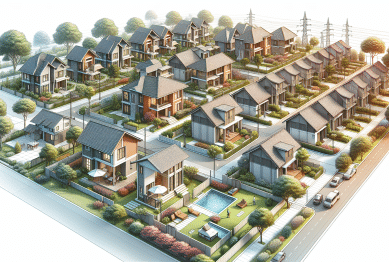Unearth the subtle factors that can accelerate or delay home sales. This in-depth guide explores how renovation choices, curb appeal tactics, digital trends, and local market shifts work together in the real estate world to impact how quickly a property reaches the closing table.
Understanding Buyer Psychology in the Home Market
The real estate market thrives on more than just numbers and listings; emotions and perceptions play pivotal roles. Homebuyers often decide within seconds whether a property feels right, sometimes before they’ve even stepped inside. This phenomenon, called the emotional trigger response, can be influenced by subtle features such as lighting, scents, and even furniture arrangements. A well-staged home with a neutral palette can elicit feelings of comfort and possibility, allowing potential buyers to visualize themselves in the space. This subconscious reaction often speeds up the decision-making process, making certain homes more appealing than others regardless of their price point or location.
Another vital aspect of buyer psychology is the sense of urgency created by perceived scarcity or competition. Seeing multiple interested parties at an open house, or learning that a home has received several offers, often pushes buyers to act quickly in fear of missing out. This competitive mindset isn’t always based on market facts but on social cues and marketing strategies by savvy agents. Houses that build this environment of demand can expect offers to arrive faster than those that appear to linger. Real estate professionals frequently leverage these tactics to stimulate rapid buyer interest, benefiting sellers seeking quick closings.
Visual cues, such as a sophisticated exterior or subtle upgrades, affect buyer confidence and trust. Properties with maintained landscaping, freshly painted doors, or updated hardware subtly suggest diligent ownership and a worry-free transition for the new resident. Because online listings drive first impressions for most shoppers today, eye-catching images further reinforce these positive perceptions. Homes that catch attention online are far more likely to receive calls and offers quickly, highlighting the increasing significance of digital presentation in selling homes efficiently (Source: HUD).
The Power of Curb Appeal and Outdoor Space Trends
Curb appeal remains a consistent driver of selling speed in residential real estate. A visually attractive frontage communicates value even before a buyer considers the home’s interior. Fresh landscaping, a tidy yard, outdoor lighting, and inviting entryways can transform an ordinary property into a sought-after listing. When these details are prioritized, the perceived value can often outpace similar homes that haven’t emphasized exterior updates, accelerating the time spent on the market. In fact, studies highlight a direct link between upgraded curb appeal and closing more deals within the first few weeks of listing (Source: NAR).
Trends in outdoor living spaces have skyrocketed in popularity with today’s buyers. Features such as functional patios, fire pits, and covered decks are increasingly sought after, especially among families eager to expand their usable living area. Installation of low-maintenance plants, sustainable landscaping, and dedicated entertainment space can substantially elevate a property’s profile online and during showings. If a home’s exterior creates a sense of sanctuary and entertainment, buyers feel drawn in, often resulting in quicker offers compared to properties lacking these amenities.
Not to be overlooked are energy-efficient upgrades such as smart irrigation, solar lighting, and native plant gardens. Homebuyers recognize these as signs of lower long-term ownership costs and environmental responsibility, making listings with eco-oriented landscaping extra competitive. In some local markets, green certifications or drought-resistant yards have become distinguishing features that allow homes to stand out and sell promptly, especially when buyers value sustainability and resource-saving practices (Source: Department of Energy).
Home Renovations That Move Properties Faster
Thoughtful home renovations play a pivotal role in quickly attracting buyers and closing deals. Upgrades to kitchens and bathrooms, in particular, consistently emerge as decision-driving preferences in buyer surveys. Modern cabinetry, energy-efficient appliances, and fresh fixtures send a signal that the home requires less immediate investment, which can accelerate the buying timeline. For those considering renovations, prioritizing functionality and style over extravagant luxury can lead to higher returns while broadening the pool of interested shoppers (Source: Habitat for Humanity).
Open floor plans are another renovation trend that can notably quicken sales. As lifestyles evolve toward communal spaces for entertainment, dining, and remote work, buyers gravitate to homes where kitchens seamlessly transition into family rooms or dining areas. Removing non-structural walls is a manageable improvement that gives even older properties a refreshed, versatile appeal. Light, airy, and adaptable rooms instantly make homes feel more spacious and suitable for a range of needs.
It’s not only grand projects that provide results—sometimes small updates go a long way. Fresh paint in neutral shades, energy-efficient lighting, and smart home features appear prominently in high-demand listings. These updates suggest move-in readiness and ease, which are attractive qualities in a competitive market. Property owners often find that even modest renovations can differentiate their listing, leading to more showings and expedited offers compared to similar homes that remain unchanged.
How Local Real Estate Markets Shape Sale Speed
No two housing markets are identical, and local trends have outsized influence on how fast a property might sell. Variables such as employment rates, school quality, new construction, and access to public transit all drive demand for certain neighborhoods. In areas with rising populations and limited inventory, homes may receive multiple offers shortly after being listed, while regions with slower job growth or higher vacancy rates might see listings linger. Understanding these micro-trends allows sellers and buyers alike to time their moves strategically for the best outcomes (Source: U.S. Census Bureau).
Seasonality is another factor influencing sale times. Spring and early summer generally see surges in buyer activity, connected to school calendars and favorable weather. However, sellers who list outside these traditional windows sometimes benefit from lower competition and more motivated buyers. Tracking past transaction volumes and the average days on market helps gauge whether the current environment is in favor of buyers or sellers. Real estate agents with local expertise offer crucial insights, adjusting marketing strategies to fit seasonal and regional swings.
Broader economic factors, such as interest rate changes or policy adjustments, also impact how swiftly homes are sold. When financing is accessible and mortgage rates fall, buyer confidence surges, leading to shorter days on market. Conversely, during periods of higher rates or uncertainty, properties may linger longer. Keeping an eye on macroeconomic signals and how they intersect with local trends can position both sellers and buyers for better success.
The Rise of Digital Tools in Real Estate Sales
Digital marketing has become integral to the real estate landscape. High-quality photos, virtual walkthroughs, and interactive floorplans now shape the majority of buyer journeys. Listings with immersive visual content consistently outperform basic ads, attracting more clicks, inquiries, and showings. Search engine optimization, social sharing, and online syndication expand a home’s reach far beyond traditional signage and print ads, dramatically accelerating the pace of transactions (Source: NAR).
For sellers, leveraging data analytics helps identify the right audience and determine optimal pricing. Online property platforms can track showing interests, pricing elasticity, and buyer feedback in real time. This data-driven approach enables faster pivots, making it easier to respond to market shifts or re-position properties that are not moving as expected. As a result, many listings now reach their ideal buyer more efficiently, making the difference between a prolonged and seamless sale process.
Even communication has been transformed by technology. Immediate responses, transparent document sharing, and remote closings make the home selling and buying process smoother than ever. Increasingly, buyers expect this level of convenience and speed, rewarding sellers who adopt modern tools with quicker outcomes. In some cases, fully virtual sales—where buyers make offers sight unseen—are no longer the exception, fueled by digital advancements and changing consumer preferences.
Pricing Strategies That Make a Noticeable Difference
Pricing a home correctly from the start is crucial for stimulating buyer interest and ensuring quicker transactions. Listings that are priced just under major search thresholds (such as $399,000 instead of $400,000) tend to appear in more buyer searches and can trigger faster activity. Setting a competitive price encourages multiple offers, which can drive up the final sale amount while also reducing time on the market (Source: Consumer Financial Protection Bureau).
Overpricing often results in listings taking longer to sell, as buyers perceive better value elsewhere or assume something is wrong with the home. Conversely, listings that are underpriced in a strategic manner can invite bidding wars, particularly in high-demand neighborhoods. Real-time data analysis gives sellers crucial insights, helping them adjust their pricing in line with current demand and competition. Engaging a real estate professional who understands local pricing nuances further increases the likelihood of a smooth and speedy sale.
Periodic price adjustments can also reinvigorate interest for homes that haven’t sold as fast as anticipated. Intelligent pricing strategies communicate motivation and flexibility while maintaining credibility with buyers and agents. Staying alert to new listings, recent comparable sales, and shifting market momentum ensures that your home remains top-of-mind among active buyers. When these pricing principles are applied, homes typically receive stronger interest, higher traffic, and quicker offers.
References
1. U.S. Department of Housing and Urban Development (HUD). (n.d.). Selling Your Home. Retrieved from https://www.hud.gov/sites/documents/DOC_20568.PDF
2. National Association of Realtors. (2023). Profile of Home Staging. Retrieved from https://www.nar.realtor/sites/default/files/documents/2023-profile-of-home-staging-05-17-2023.pdf
3. U.S. Department of Energy. (n.d.). Energy-Efficient Home Design. Retrieved from https://www.energy.gov/energysaver/energy-efficient-home-design
4. Habitat for Humanity. (n.d.). Renovations That Increase Home Value. Retrieved from https://www.habitat.org/stories/renovations-increase-home-value
5. U.S. Census Bureau. (n.d.). Housing. Retrieved from https://www.census.gov/topics/housing.html
6. Consumer Financial Protection Bureau. (n.d.). Guide to Selling Your Home. Retrieved from https://www.consumerfinance.gov/owning-a-home/process/sell/









